Overview
- The Fidelity Account
- Compare Online Brokers
- Awards & Recognition
- Compare Service Levels
- Margin Loans
- Fully Paid Lending
- FAQs
-
Technology
-
Pricing
Investment Choices
General order types
-
What is a market order?
A market order instructs Fidelity to buy or sell securities for your account at the next available price. It remains in effect only for the day, and usually results in the prompt purchase or sale of all the shares of stock or options contracts in question, as long as the security is actively traded and market conditions permit.
Note: In order to maintain a fair and orderly market, most market centers generally do not accept cancellation requests after 9:28 a.m. ET for market orders eligible for execution at 9:30 a.m. ET, when the market opens. Acceptance of a cancellation request by Fidelity between 9:28 and 9:30 a.m. ET does not guarantee an order cancellation. All requests to cancel an order are processed on a best-efforts basis.
-
What is a limit order?
When you place a limit order to buy, the stock is eligible to be purchased at or below your limit price, but never above it.
You may place limit orders either for the day on which they are entered (a day order), or for a period that ends when it is executed or when you cancel (an open order or good ’til canceled (GTC) order).
Note: All open GTC orders will expire 180 calendar days after they are placed. If the 180th day falls on a weekend or holiday, those orders will expire on the first business day following the expiration day. This policy does not apply to options.
Orders at each price level are filled in a sequence that is determined by the rules of the various market centers; therefore, there can be no assurance that all orders at a particular price limit (including yours) will be filled when that price is reached. Such orders are also subject to the existence of a market for that security. Thus, the fact that your price limit was reached does not guarantee an execution.
Limit orders for more than 100 shares or for multiple round lots (200, 300, 400, etc.) may be filled completely or in part until completed. It may take more than one trading day to completely fill a multiple round lot or mixed-lot order unless the order is designated as one of the following types:
- All or none (fill the whole order or no part of it). When you place an all-or-none designation on your order, it is considered restricted. The stock can trade at or below your price on a buy, or at or above on a sell, without the right to execution, unless the entire amount of your order is executable.
- Immediate or cancel (fill the whole order or any part immediately, and cancel any unfilled balance).
- Fill or kill (fill the entire order immediately or cancel it).
Note: Good 'til canceled time in force is not available for short sales. We do not accept limit orders for mutual funds.
-
What is a stop order?
Stop orders are generally used to protect a profit or to prevent further loss if the price of a security moves against you. They can also be used to establish a position in a security if it reaches a certain price threshold or to close a short position.
The specialists on the various exchanges and market makers have the right to refuse stop orders under certain market conditions. Not all securities or trading sessions (pre- and post-market) are eligible for stop orders.
- Types of stop orders
- Stop loss
This type of order automatically becomes a market order when the stop price is reached. Therefore, there is no guarantee that your order will be executed at the stop price. - It is important for investors to understand that company news or market conditions can have a significant impact on the price of a security. This could result in a stop loss order being executed at a price that is dramatically different than what your stop loss price indicates.
- Stop limit
This type of order automatically becomes a limit order when the stop price is reached. Like any limit order, a stop limit order may be filled in whole, in part, or not at all, depending on the number of shares available for sale or purchase at the time. - Note: Buy stop loss and buy stop limit orders must be entered at a price which is above the current market price. Sell stop loss and sell stop limit orders must be entered at a price which is below the current market price.
- Stop loss
- How stop orders are triggered
- Stocks
Equity stop orders placed with Fidelity are triggered off of a round lot transaction of 100 shares or greater, or a print in the security. The market centers to which National Financial Services (NFS) routes Fidelity stop loss orders and stop limit orders may impose price limits such as price bands around the National Best Bid or Offer (NBBO) in order to prevent stop loss orders and stop limit orders from being triggered by potentially erroneous trades. These price limits may vary by market center. If you are interested in placing an order which triggers off of a bid quote or ask quote, please see Trailing Stop Orders and Contingent Orders. - Options
Generally a stop order to buy becomes a market order when the bid price is at or above the stop price, or the option trades at or above the stop price. A stop order to sell becomes a market order when the ask price is at or below the stop price, or when the option trades at or below the stop price. The options stop election is based on the exchange’s best bid or offer (BBO) where the stop order resides.
- Stocks
- Types of stop orders
-
What time limitations and additional instructions can I place on an order?
You place a time limitation on a stock trade order by selecting one of the following time-in-force types:
Day
A time-in-force limitation on the execution of an order. This limitation has a default order expiration time of 4:00 p.m. ET. You may select your own order expiration time between 10:00 a.m. ET and 4:00 p.m. ET in thirty minute increments (i.e., 10:00 a.m., 10:30 a.m., 11:00 a.m., etc). If all or part of your order is not executed by the time you’ve selected for expiration, your order will be canceled. You may view the status of your order, including order expiration date and/or time, on the Orders page.Good 'til canceled
A time-in-force limitation that can be placed on a stock or ETF order. This limitation has a default order expiration date of 180 calendar days from the order entry date at 4:00 p.m. ET. You may select your own order expiration date and/or time, up to 180 calendar days from the order entry date. If all or part of your order is not executed by the date and/or time you've selected for expiration, any open portions of your order will be canceled. You may view the status of your order, including order expiration date and/or time on the Orders page.Fill or kill
A time-in-force limitation that can be placed on the execution of an order. This limitation requires that the order is immediately completed in its entirety or canceled.Orders with the fill or kill limitation:
- are for 100 shares or more
- are only placed during market hours
- are good only for the current day
- are not allowed for use with stop loss, stop limit, or sell short orders
Note: Fill or kill is only used under very special circumstances. If you do not fully understand how to use fill or kill, talk to a Fidelity representative before placing this limitation of an order.
Immediate or cancel
A time-in-force limitation that can be placed on the execution of an order. This limitation requires that a broker immediately enter a bid or offer at a limit price you specify. All or a portion of the order can be executed. Any portion of the order not immediately completed is canceled.On the open
A time-in-force limitation that can be placed on an order. This limitation requires that the order is executed as close as possible to the opening price for a security. All or any part of the order that cannot be executed at the opening price is canceled.On the close
A time-in-force limitation that can be placed on the execution of an order. This limitation requires that the order is executed as close as possible to the closing price for a security. All or any part of the order that cannot be executed at the closing price is canceled.Additional order instructions can be entered on certain orders.
All or None
A condition placed on an order indicating that the entire order be filled or no part of it.Do Not Reduce
A condition on a Good 'til Canceled Limit order to buy or a stop order to sell a security. This condition prevents the order limit or stop price from being reduced by the amount of the dividend when a stock goes ex-dividend or the stock's price is reduced due to a split.All or None/Do Not Reduce
An order with a condition indicating that the entire order be filled or no part of it, as well as a condition on a limit order to buy or a stop order to sell a security. This condition prevents the order limit or stop price from being reduced by the amount of the dividend when a stock goes ex-dividend or the stock's price is reduced due to a split. Only allowed on Good 'til Canceled orders.Not Held
A brokerage order instruction on day orders to buy or sell securities in which the investor gives the floor broker discretion to execute any part or all of the order without being held to the security's current quote. Not Held orders are usually used on large blocks of securities when a purchase or sale cannot be executed as a single trade. An instruction to put a Not Held discretion on an order must be called in to a trading representative. -
How are commissions assessed for good 'til canceled orders?
The commission for a good 'til canceled order is assessed at the time your order is executed.
If your order receives multiple executions on a single day, you will be assessed one commission. For good 'til canceled orders that receive executions over multiple days, a commission is assessed for each day in which there is an execution.
Good 'til canceled orders that do not execute are not charged a commission.
-
How do dividend distributions affect open orders?
Although different exchange rules may exist for adjusting orders when a security pays a dividend, the general rule is that good 'til canceled (GTC) orders below the market are adjusted for the dividend amount. The price of your order will be automatically reduced on the "ex-dividend" date by approximately the amount of the upcoming dividend unless you note it as a do not reduce (DNR) when you place the order. Orders below the market include: buy limit, sell stop loss, sell stop limit, sell trailing stop loss, sell trailing stop limit.
-
What are the risks of trading in volatile markets?
Volatile markets can present higher trading risks, especially when you are using electronic services to access information or place orders.
- Consider placing limit orders instead of market orders. In certain market conditions, or with certain types of securities offerings (such as IPOs and financial stocks), price changes may be significant and rapid during regular or after-hours trading. In these cases, placing a market order could result in a transaction that exceeds your available funds, meaning that Fidelity would have the right to sell other assets in your account to cover any outstanding debt. This is a particular risk in accounts that you cannot easily add money to, such as retirement accounts.
- Be aware that quotes, order executions, and execution reports could be delayed. During periods of heavy trading or volatility, quotes that are provided as “real time” may be stale—even if they appear not to be—and you may not receive every quote update. Security prices can change dramatically during such delays.
- When canceling an order, be sure your original order is actually canceled (verified canceled order status) before entering a replacement order. Don’t rely on a receipt for your cancellation order; that order may have arrived too late for us to act on. Cancellation requests are handled on a best-efforts basis.
- Use other ways to access Fidelity during peak volume times. System availability and response time may be subject to market conditions. If you are having problems reaching us one way, try another. There are several ways to contact Fidelity.
The chances of encountering these risks are higher for individuals using day trading strategies. In part for this reason, Fidelity does not promote day trading strategies. For more information on trading risks and how to manage them, contact Fidelity.
Advanced order types
-
What is a Trailing Stop Order?
Trailing Stop Orders adjust automatically when market conditions move in your favor, and can help protect profits while providing downside protection. With a Trailing Stop Order, you do not have to constantly adjust for price changes.
Additionally, Trailing Stop Orders may have increased risks due to their reliance on trigger processing, market data, and other internal and external system factors. These orders are held in a separate order file with Fidelity and are not sent to the marketplace until the order conditions you've defined have been met.
Eligible securities:
- Listed and OTC Equities
- Single-leg Options
Types of Trailing Stop Orders:
- Trailing Stop Loss: Once triggered, the order will become a market order.
- Trailing Stop Limit: Once triggered, the order will become a limit order.
Trailing Stop Order trigger values:
You may elect to trigger a Trailing Stop order based on the following security market activities:- The security's last round lot trade of 100 shares or greater (default)
- The security's bid price
- The security's ask price
Trailing Stop Order time limits:
- Trailing Stop orders can be either Day orders or Good 'til Canceled (GTC) orders.
- GTC orders placed on Fidelity.com expire after 180 days.
Trailing Stop Order trail values:
- Equity Trailing Stop orders can be set with a percentage (%) or dollar ($) trail value.
- Single-leg Option Trailing Stop orders can only be set with a dollar ($) trail value.
Important information regarding Trailing Stop Orders (PDF)
Example of a Trailing Stop Order
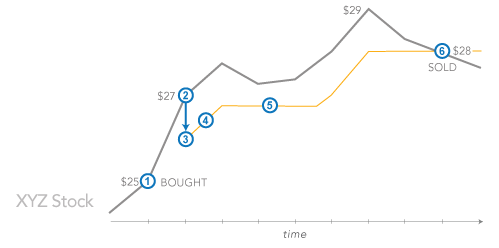 1. You buy XYZ stock at $25 per share.
1. You buy XYZ stock at $25 per share.
2. XYZ rises to $27.
3. You place a sell trailing stop loss with a trail value of $1.
4. As long as the price moves in your favor, your trailing price will stay $1 away.
5. The price of XYZ peaks at $29, then starts to drop. Your trailing stop loss remains at $28.
6. Shares are sold when XYZ reaches $28. -
What is a conditional order?
A conditional order allows you to set order triggers for stocks and options based on the price movement of stocks, indices, or options contracts. There are four types: Contingent, One-Triggers-the-Other (OTO), One-Cancels-the-Other (OCO), and One-Triggers-a-One-Cancels-the-Other (OTOCO).
- Contingent
A Contingent order triggers an equity or options order based on any 1 of 8 trigger values for any stock, up to 40 selected indices, or any valid options contract.- Trigger values: last trade, bid, ask, volume, change % up, change % down, 52-week high, and 52-week low
- Market, limit, stop loss, and trailing stop loss are available order types once the contingent criterion is met.
- Security type: Stock or single-leg options
- Time-in-force: For the contingent criteria and for the triggered order, it can be for the day, or good 'til canceled (GTC). The time-in-force for the contingent criteria does not need to be the same as the time-in-force for the triggered order.
Example of a Contingent Order
 1. You place a Contingent order to buy XYZ stock at a limit of $25—if the UVW index moves up more than 1.25%.
1. You place a Contingent order to buy XYZ stock at a limit of $25—if the UVW index moves up more than 1.25%.
2. A rally occurs that pushes the index up 1.30% on the day…
3. …which triggers a limit order to buy XYZ at $25.
4. XYZ hits your limit of $25 so shares are bought.- One-Triggers-the-Other (OTO)
A One-Triggers-the-Other order actually creates both a primary and a secondary order. If the primary order executes, the secondary order automatically triggers. - This type of order can help you save time: place a buy order as your primary order and a corresponding sell limit, sell stop, or sell trailing stop at the same time. Or, if you trade options regularly, use an OTO order to leg into a buy-write or covered-call position.
- Trailing stop orders are available for either or both legs of the OTO.
- Security type: Any combination of stock and/or single-leg options
- Time-in-force: Can be different for each order
- For OTO orders that are good 'til canceled (GTC), the whole order is good for 180 days (e.g., if the primary order executes on day 30, the secondary order is live for 150 days).
- If the primary order is canceled, the secondary order is also canceled.
- If the secondary order is canceled, the primary order remains open as a separate order.
Example of One-Triggers-the-Other Order
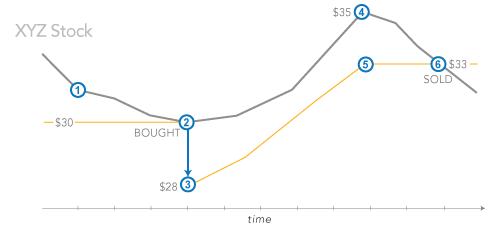 1. You place an OTO to buy XYZ at $30 and sell at a $2 trailing stop loss.
1. You place an OTO to buy XYZ at $30 and sell at a $2 trailing stop loss.
2. The stock drops to $30, which triggers a buy order of XYZ stock that executes and…
3. …a sell trailing stop loss order with a $2 trail is placed with an initial trigger price of $28.
4. XYZ moves up to $35…
5. …so the new trigger price for the trailing stop order is $33.
6. XYZ trades down to $33, which triggers the trailing stop order and shares are sold at the market.- One-Cancels-the-Other (OCO)
With a One-Cancels-the-Other (OCO) order, two orders are live so that if either executes, the other is automatically triggered to cancel. - When orders are placed for retirement accounts, a price-reasonability check helps prevent both OCO orders from executing in a fast market. This feature does not exist in nonretirement accounts.
- Security type: Any combination of stocks or single-leg options
- Time-in-force: Must be the same for both orders
- Orders can be for the same shares of the same stock or option contracts, but on opposite sides of the market (sell limit and sell stop).
Example of One-Cancels-the-Other Order
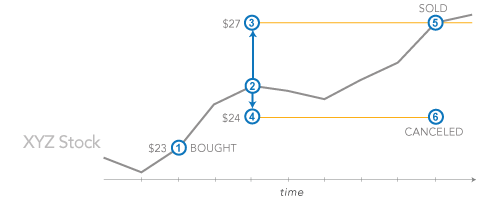 1. You buy XYZ stock at $23.
1. You buy XYZ stock at $23.
2. XYZ stock rises to $25.
3. You place an OCO with a sell order of $27 and…
4. …a sell stop at $24.
5. XYZ stock hits $27, so your sell order executes and…
6. …your sell stop order is canceled.- One-Triggers-a-One-Cancels-the-Other (OTOCO)
With a One-Triggers-a-One-Cancels-the-Other order, you place a primary order which, if executed, triggers two secondary orders. - If either of these secondary orders executes, the other is automatically canceled.
- Security type: Any combination of stocks or single-leg options
- Time-in-force: Primary can be different than both secondary orders. However, both secondary orders must have the same time-in-force.
Example of One-Triggers-a-One-Cancels-the-Other Order
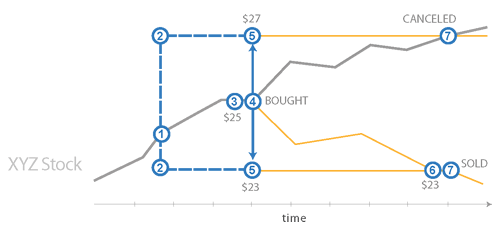 1. You place an order to buy XYZ at $25.
1. You place an order to buy XYZ at $25.
2. At the same time, you place two sell orders, one at stop loss for $23 and one at a limit of $27.
3. XYZ trades at $25.
4. Your buy order executes.
5. Simultaneously, your two sell orders are triggered.
6. XYZ drops to $23.
7. Your stop loss order executes and your limit order is automatically canceled. - Contingent
-
What is short selling?
Short selling is an advanced trading technique that allows you to integrate a number of different strategies into your overall investment approach so that you may potentially profit from downward moves in a particular stock. However, if the price of the security that you have sold short goes up, you may incur a loss which may be unlimited. Fidelity customers with a margin agreement in place may enter short sale and buy-to-cover orders for any U.S. stock using our online trading platform. All short sale orders are subject to the availability of the stock being sold, which must be confirmed by our stock loan department prior to the order being entered. In addition, you may be charged a short interest fee on the securities that you have borrowed to sell short and those fees may change, sometimes significantly without warning.
Potential uses of short selling:
- Hedge current portfolio by short selling similar stocks or ETFs when you think the market may go down in the short term but don’t want to sell the stocks you own to incur short-term capital gains.
- Profit from the decline of a particular stock, an entire industry, or the overall market.
- Extend a bearish position when in-the-money calls you’ve written are exercised.
Example of a Short Sale
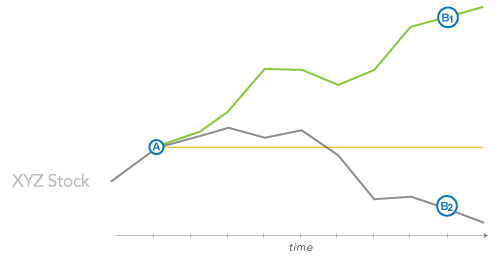 1. Seller shorts stock at price A. Fidelity finds shares that can be borrowed for delivery.
1. Seller shorts stock at price A. Fidelity finds shares that can be borrowed for delivery.
2. Three trading days later, on settlement date, Fidelity provides shares for delivery. Seller then pays a variable interest rate on loan of shares for as long as the short position is maintained.
3. Seller enters a buy to cover order at price B. If the price is above the price at which it was originally sold short (B1), the short seller generally realizes a loss. If it is below the original selling price (B2), the short seller generally realizes a profit.*
*Note that other factors may have an impact on profit or loss of the trade.
More information
Stock FAQs
Learn more about international stock trading and IPOs.
Fidelity Trader+™ FAQs
Get details on our most powerful trading experience yet. Available at no cost across your devices.
Fidelity Learning Center
Build your investment knowledge with this collection of training videos, articles, and expert opinions.

